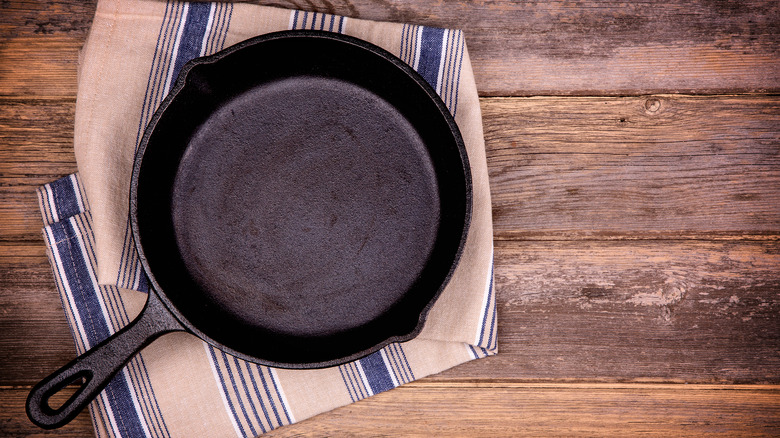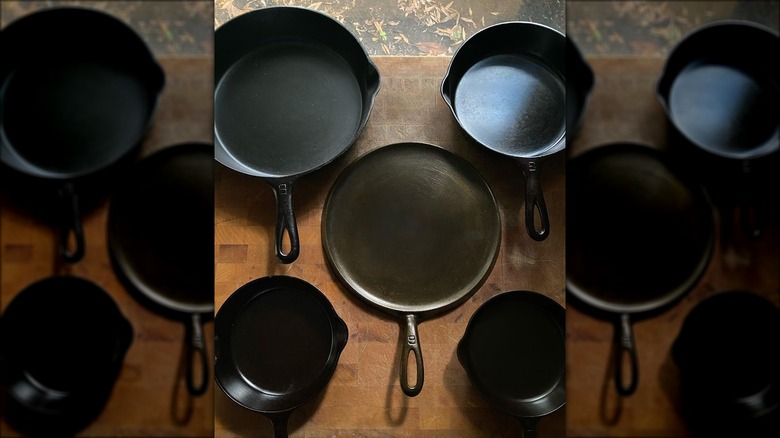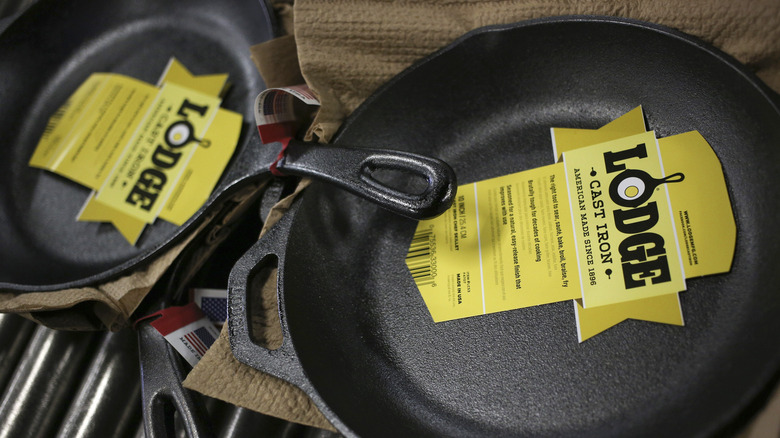Your Cast Iron Pan Wasn't Always So Rough
It may seem like the cast iron obsession so prevalent in foodie circles is a modern phenomenon, but it turns out that humans have actually been smelting iron since 800 BCE, during the Zhou Dynasty in China, as explained by Eater. Once you realize just how long the legacy of cast iron has loomed over us all, it makes sense that it might have undergone some major changes over the centuries. But one that might puzzle thrift store shoppers, flea market junkies, and Lodge fans alike is this: how come vintage cast iron pans are so smooth compared to the rough cast iron skillets and Dutch ovens made today?
The main reason is that the primary cast iron manufacturing method changed in the 1950s. As the economy began to recover from the Great Depression and WWII, cast iron manufacturers began to increase their production, and the automatic molding process was invented. Cast iron skillets are made by pouring or injecting molten iron into sand molds. Previously, the process was done by hand, and the pans were tumbled for up to 24 hours to polish that texture away, leaving a smooth surface. But once molten cast iron no longer had to be poured by hand, production speed increased, and the time-consuming polishing step was eliminated. In order to counteract the rough texture of modern cast iron, people began seasoning their pans, and Lodge started making pre-seasoned cast iron cookware. But does rough cast iron actually cook food differently than smooth, vintage cast iron?
The benefits of cooking with vintage cast iron
There are some people who swear by cooking with smooth-surfaced cast iron. Dennis Powell Jr., founder of Butter Pat Industries cast iron cookware, began making his own cast iron pans in order to bring back that vintage-style smooth surface. For one thing, it's more durable. "If your cast iron has a smooth surface, you can clean it with water, use steel wool on it, and scrape things off of it with a paint scraper without damaging the cooking surface," he shared with Food & Wine, because "the smoothness" of the pans helps food not stick to them, not the seasoning. Vintage cast iron also tends to be lighter and easier to handle than modern cast iron.
Those who want to try cooking with vintage, smooth cast iron should keep a few things in mind. Restoring vintage cast iron can be a lengthy process, meaning you'll likely end up paying for it either in elbow grease, or cold hard cash if you're buying a restored piece, especially from a well-known maker like Griswold or Wagner. Then, there are some key indicators of quality to look for. Check vintage pans for any surface pitting or cracks, and try to make sure they're level and not warped, vintage cast iron expert Kyle Seip shared with Bon Appétit. He also recommends looking for pans that were made in areas with lots of iron mining, and thus access to quality iron ore, like Pennsylvania and Ohio.
Modern cast iron
In 1997, the New York Times bemoaned that "cast iron skillets have fallen out of favor." Little did they know that just a few decades later, popular TV stars would own dozens — The Pioneer Woman owns more than 25 cast iron skillets — or that in just 20 years, they'd be publishing notices about vintage cast iron sales featuring pieces that cost up to $250. But with cast iron's renaissance, the modern cast iron world has seen some changes, too — mainly, that some smaller cast iron brands are bringing back the smooth style that was once so popular.
These days, the most common household name in American cast iron cookware is Lodge. Lodge's pans are made using the modern method, which produces that rougher surface texture. But there are some modern brands that are keeping the smooth polished, hand-cast tradition alive. However, you'll have to shell out the big bucks for many of these newer, smooth options — sometimes literally hundreds more. If you're on a budget, then opting for a modern, rough-textured cast iron skillet is probably the best bet, especially when you consider the fact that in many side-by-side tests and rankings, Lodge skillets outperform both vintage and modern smooth cast iron.


